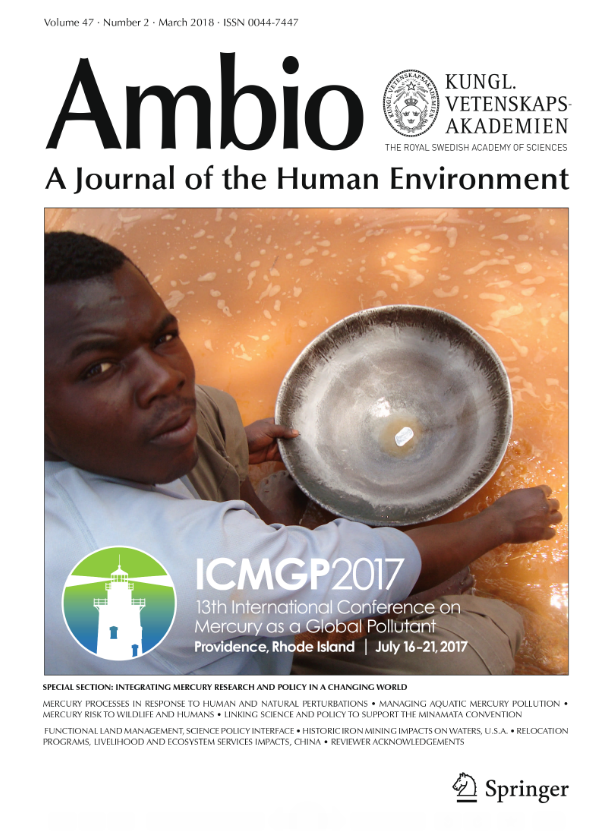February 7, 2018 – How is mercury pollution responding to climate change? Where are mercury hot spots around the world? How can science support a global treaty against the dangerous pollutant?
| Image  |
| Covering Mercury. A special issue of the journal Ambio features the latest in mercury science. (Cover © Springer/RSAS) |
Just months after two international meetings, researchers have published a series of scholarly articles that seek to answer these questions. The papers detail the dangers of mercury and provide scientific insight into how mercury pollution is reacting to a changing world.
Representing the state-of-the-art understanding of the world’s mercury problem, it is hoped that the papers will provide policymakers with the science they need to combat mercury under the Minamata Convention on Mercury, a global treaty that entered into force in August of last year.
“Years of research have led us to the point where we have a more complete scientific understanding of the global mercury problem,” said Celia Chen, a research professor in Dartmouth’s Department of Biological Sciences. “These papers offer the most rigorous and current scientific research to support efforts to combat mercury pollution.”
While the research already existed in the public domain, the new packaging of the science in a special issue of the journal Ambio, offers an accessible and eye-opening read on a pollutant that impacts much of the world’s population. The political context has also changed, since these research findings were first released before the treaty entered into force.
“Scientific guidance to policymakers is absolutely essential to ensure that the Minamata Convention is effective in controlling and eliminating mercury pollution,” said Chen, a lead researcher with the Dartmouth Toxic Metals Superfund Research Program.
Four complete studies authored by experts from around the world were included in the journal series. Chen was a guest editor of the special issue with Charles Driscoll, a professor of environmental systems engineering at Syracuse University. Chen and Driscoll also co-authored a cover article entitled “Integrating mercury research and policy in a changing world.”
Formally known as synthesis papers, the studies are the product of the 13th International Conference on Mercury as a Global Pollutant (ICMGP2017). Summaries of the papers were also presented to delegates who met to discuss the global treaty at the first “Conference of Parties” held in September in Genève, Switzerland.
According to Springer, the publisher of Ambio: “This special issue represents the latest results from international mercury science and policy communities and will provide a basis in the coming years for developing policy to minimize environmental effects and exposure to this contaminant.”
Mercury is a complex pollutant that is dangerous for humans, wildlife and the environment. It is estimated that around two-thirds of the mercury entering the environment comes from human sources including mining, industrial activities, coal combustion and incinerators.
Methylmercury is the most toxic form of mercury. The most common risk of mercury poisoning for humans comes the consumption of fish and shellfish, although exposure to mercury also occurs through mining, industrial processes and even some cultural practices.
“The control and management of mercury pollution require both global and local efforts,” said Chen in her article. “The time is optimal for translating the science of mercury pollution and providing guidance to policymakers.”
Recognizing that efforts are being made to reduce mercury contamination, Chen also notes that “the extent and rate of potential recovery is unclear because of uncertainties in our understanding of mercury transport, cycling and trophic transfer in the face of global change.”
Chen co-chaired ICMGP2017 last July in Providence, Rhode Island. Chen also addressed the Genève meeting on the Minamata Convention.
The Dartmouth Toxic Metals Superfund Research Program uses an interdisciplinary approach to investigate the ways in which arsenic and mercury in the environment affect ecosystems and human health.

